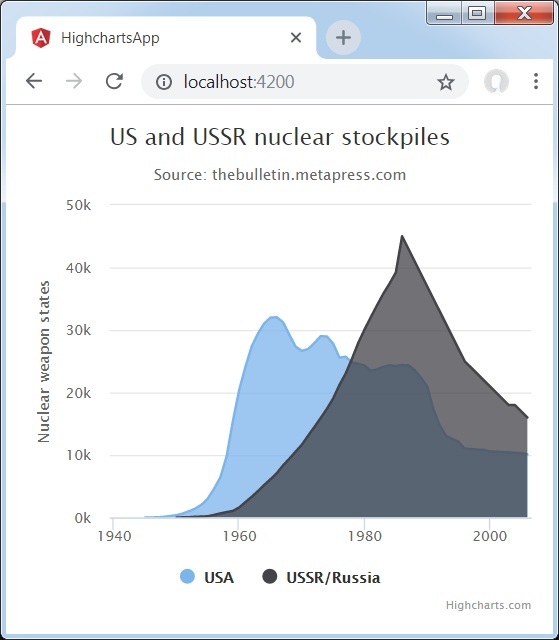
- Angular Highcharts - Home
- Angular Highcharts - Overview
- Environment Setup
- Configuration Syntax
- Angular Highcharts - Line Charts
- Angular Highcharts - Area Charts
- Angular Highcharts - Bar Charts
- Angular Highcharts - Column Charts
- Angular Highcharts - Pie Charts
- Angular Highcharts - Scatter Chart
- Angular Highcharts - Dynamic Charts
- Angular Highcharts - Combinations
- Angular Highcharts - 3D Charts
- Angular Highcharts - Map Charts
Angular Highcharts - Basic Area Chart
We have already seen the configuration used to draw this chart in Highcharts Configuration Syntax chapter. Let us now consider the following example to further understand a basic area chart.
Example
app.component.ts
import { Component } from '@angular/core';
import * as Highcharts from 'highcharts';
@Component({
selector: 'app-root',
templateUrl: './app.component.html',
styleUrls: ['./app.component.css']
})
export class AppComponent {
highcharts = Highcharts;
chartOptions = {
chart: {
type: 'area'
},
title: {
text: 'Average fruit consumption during one week'
},
subtitle : {
style: {
position: 'absolute',
right: '0px',
bottom: '10px'
}
},
legend : {
layout: 'vertical',
align: 'left',
verticalAlign: 'top',
x: -150,
y: 100,
floating: true,
borderWidth: 1,
backgroundColor: (
Highcharts.theme && Highcharts.theme.legendBackgroundColor) || '#FFFFFF'
},
xAxis:{
categories: ['Monday','Tuesday','Wednesday','Thursday','Friday','Saturday','Sunday']
},
yAxis : {
title: {
text: 'Number of units'
},
labels: {
formatter: function () {
return this.value;
}
},
min:0
},
tooltip : {
formatter: function () {
return '<b>' + this.series.name + '</b><br/>' +
this.x + ': ' + this.y;
}
},
plotOptions : {
area: {
fillOpacity: 0.5
}
},
credits:{
enabled: false
},
series: [
{
name: 'John',
data: [3, 4, 3, 5, 4, 10, 12]
},
{
name: 'Jane',
data: [1, 3, 4, 3, 3, 5, 4]
}
]
};
}
Result
Verify the result.

angular_highcharts_area_charts.htm
Advertisements